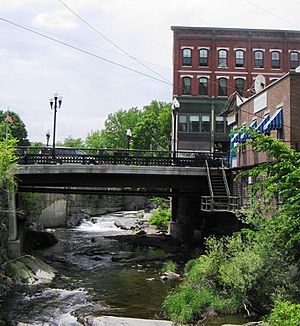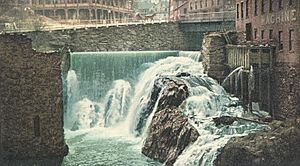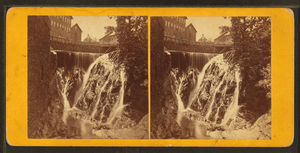Whetstone Brook facts for kids
The Whetstone Brook is a small river, also called a tributary, that flows into the larger Connecticut River. It runs right through the middle of Brattleboro, Vermont, in the United States. The brook starts high up at Hidden Lake in Marlboro, about 1,500 feet (457 meters) above sea level. From there, it travels down to meet the Connecticut River at about 250 feet (76 meters) above sea level.
The area of land that collects water for the Whetstone Brook is called its watershed. This watershed covers about 28 square miles (72.5 square kilometers). Most of this area, over two-thirds, is in Brattleboro. About 30 percent is in Marlboro, and a small part, 2 percent, is in Dummerston. A famous landmark, the Creamery Covered Bridge, built in 1879, crosses the Whetstone Brook in West Brattleboro.
History of Whetstone Brook
Whetstone Brook played a very important role in the growth of Brattleboro. Its flowing water provided power for many mills and factories built along its banks.
The first gristmill, which grinds grain into flour, was set up near the brook in 1762 by Governor Wentworth of New Hampshire. At this time, the land was still being argued over by the colonies of New York and New Hampshire. By 1773, the area around Whetstone Brook had several sawmills, which cut wood, and homes for new settlers moving into the region. The brook's power helped Brattleboro become a busy and important town.
Keeping Whetstone Brook Clean
For a long time, the Whetstone Brook faced challenges with pollution from the nearby town of Brattleboro. In 1907, a local newspaper even wrote about how dirty the brook had become.
However, many efforts have been made to clean up and protect the brook. For example, in 1990, the Vermont Department of Environmental Conservation found that oil was leaking from an underground storage tank. A big cleanup project followed, removing nearly 4,000 gallons (about 15,140 liters) of oil from the water and soil. This cleanup cost $440,000 and is now used by the Environmental Protection Agency (EPA) as a good example of how local and national groups can work together to clean up oil spills.
As of 2007, the lower 2.5 miles (4 kilometers) of the brook, where many buildings are located, still had some bacteria like E. coli. In 2011, during Hurricane Irene, a pipe that carries sewage broke. Luckily, quick action prevented a large amount of sewage from spilling into the brook. These efforts show how important it is to keep Whetstone Brook healthy for everyone.




